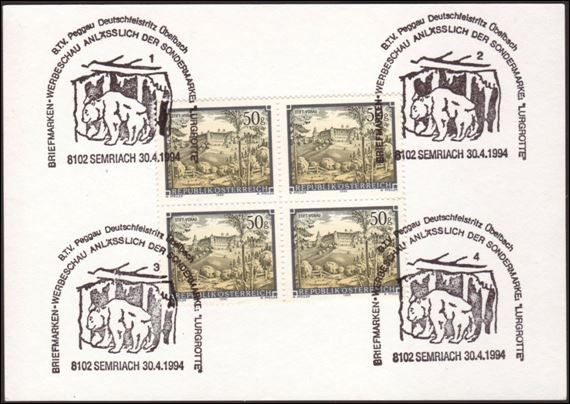Calendrier
Notre association
Nos activités
-

 Année 2018
Année 2018 -

 Année 2019
Année 2019 -

 Année 2021
Année 2021 -

 Année 2022
Année 2022
Vidéos Membres
-
Jean-Marc Fellag
Revues gratuites
Thématique
Les collections
-

 Conférences
Conférences -

 Thématique grottes
Thématique grottes
Ephéméride
Mardi 23 Déc. 2025
Bonne fête à tous les :
Armand
C'était aussi un 23 Déc.
1973
L'OPEP décide de doubler le prix du pétrole brut : premier choc pétrolier.
Né(e) un 23 Déc. 1968
Carla Bruni
Annuaire de la Poste
 Spéléologie - Grotte de Lur - Page 1 (en)
Spéléologie - Grotte de Lur - Page 1 (en)
Speleology - Lur cave - Page 1
Issue of the stamp "Lurgrotte" of April 29th, 1994.

Face value 6 Schilling = domestic tariff for letter.
Advance sale from April 29th to May 1st, 1994.
The Lurgrotte karst cave is the largest cave in the eastern Alps of Styria, Austria . It is located about 16 km (9.9 mi) north of Graz and runs through the Tannenben karst region. The cave has two accessible entrances, one at the village of Semriach and the other at the village of Peggau. At the entrance to Semriach, the river Lur flows into the cave. At the entrance to Peggau, the River Schmelz emerges from inside the cave, flows westwards and finally joins the River Mur.
Historical background:
The cave was first explored scientifically by the Italian cave explorer Max Brunello on April 1st, 1894. While the upper parts of the cave were known to the inhabitants, Brunello was the first to discover the lower part of the cave. The next attempt at exploration led to another catastrophe.
On April 29th, 1894, seven cavers entered the Lurgrotte, despite heavy rains. A flash flood occurred while they were inside, and they were trapped for ten days. Emperor Franz Joseph I approved a rescue effort, employing a large number of workers, miners and divers, who returned to the water and successfully rescued the trapped cavers.
(Source Wikipédia)
Catégorie : - Thématique
Page lue 937 fois





 ]
] 106 membres
106 membres



